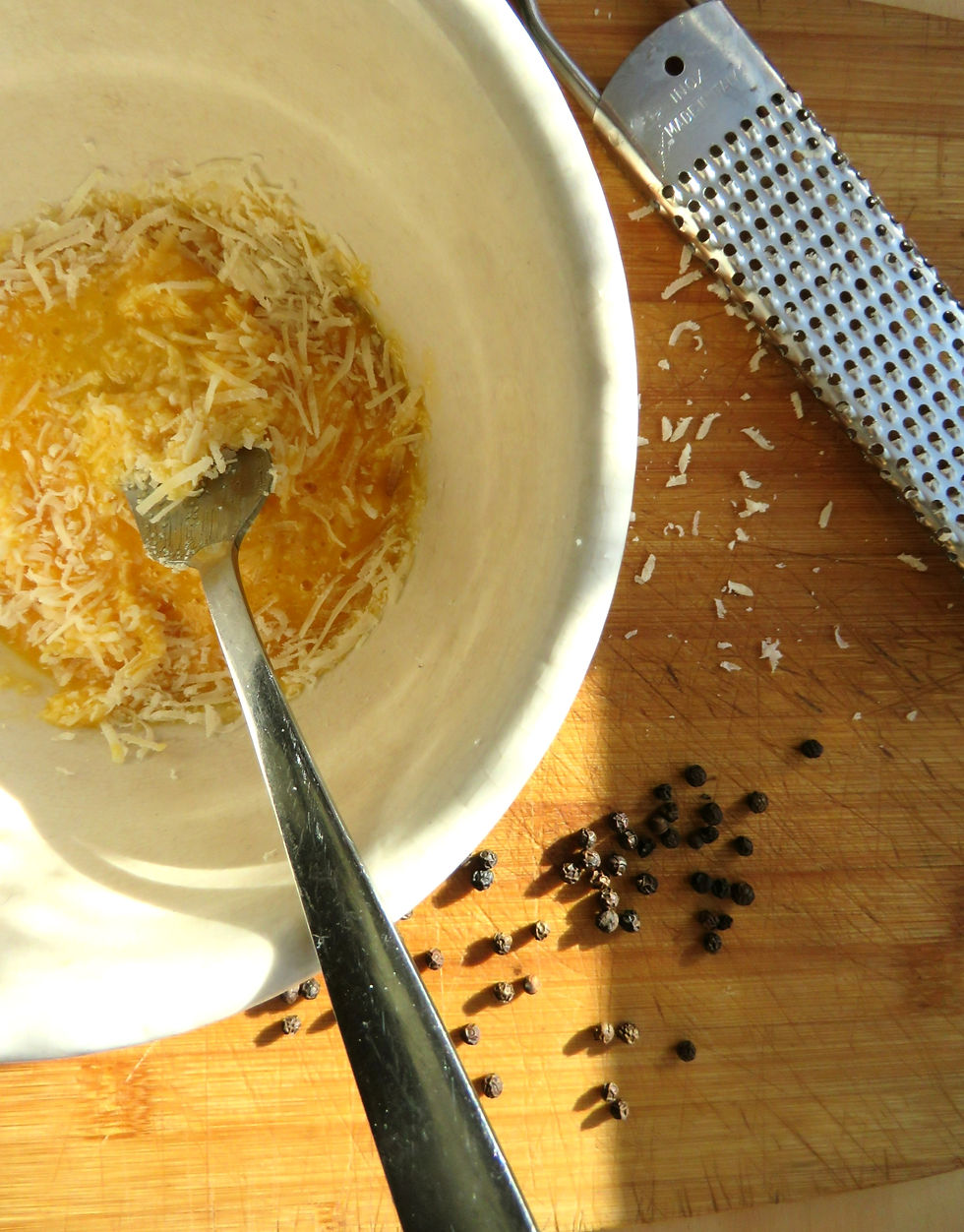The Trick to Proper Carbonara
- Mangia Mangia
- Feb 10, 2023
- 4 min read
Updated: Sep 17, 2024
This is not a complex dish, but to get it right takes some inside knowledge.

Carbonara is up there with amatriciana, ragù alla bolognese, pesto all genovese and arrabbiata - classic, Italian pasta sauces - some complex, some not - carbonara is not. But you need to be 'in the know'.
Firstly, the ingredients
Would you believe me if I said there were only four?
We all know the importance of beautiful ingredients to make beautiful food and Italy is an advocate for ensuring every product is sublime, always saying: If you've got gorgeous cheese and gorgeous bread, you've got yourself a gorgeous panino. That simple.
Yes, you can use pancetta, you can even put cream in it, or heaven-forbid onions - but expect any Roman to frown deeply at your choices because as world-wide as it's become, la carbonara is as Roman as Giulio Cesare.
Or is it?
There's an ongoing food feud between Roma and Napoli - Naples claim they make the best pizza, they also invented it, Rome says no they did. Rome gets to claim most things being the centre of Italy and the world (according to everyone, except the Napolitani) and they've claimed this pasta sauce too. But unlike cacio-pepe (Rome's other famous pasta sauce, along with l'amatriciana) which is blatantly Lazio (the region around Rome), carbonara only came into play during the war in the 1940s. Some say it was inspired by American soldiers who loved eggs and bacon. They allegedly added pancetta, or Rome's form of it, guanciale, to a similar dish - cacio e ova (cheese and egg) from nearby east-coast region of Abruzzo. Interesting that the dish was made by the charcoal-makers, called carbonai in Italian, carbonari in Roman dialect.
Then some contradictors say in, you guessed it, Naples, where street food was immensely popular amongst the American troops, when their K rations were added to the quickly thrown-together spaghetti cacio e pepe, a new recipe was born. Perhaps the Romans decided to take powdered eggs, bacon and liquid cream up to more appropriate culinary levels and therefore claimed it as theirs! Who knows, but it's theirs now.

Back to the ingredients, after you've selected your piece of cured pork cheek - guanciale (not pre-chopped mind, it loses the flavour), all you need is black pepper, pecorino and eggs. You're welcome to use cacio (another sheep cheese from the area but softer) or even mix the grated cheeses with Grana Padano or Parmigiano Reggiano to soften the sharp flavour - I'm simply telling you how a Roman would tell you
Find a box of spaghetti (spaghetti come in different thicknesses - if we may suggest 'Spaghetti della De Cecco N.12') find an extra-large pot for the pasta and hey presto, you're ready to go.
After the right ingredients, the trick to proper carbonara is
The process - there are two.
The bain-marie method and the 'not'.
A couple of chefs get very technical about the creaminess of the sauce. Because egg protein starts coagulating at 65°C and stops at 70°C, a thermometer is needed to make sure the cooked sauce is perfectly creamy and not scrambled. But honestly, nobody used a bain-marie and probe thermometer back in the 40s so feel free to use the 'not' method.
And the rest is simple - follow these instructions and you'll have yourself the closest carbonara to Chef Luciano Monosilio's you can get.
1. Put a pot of boing water on to boil for the bain-marie if you're going chef-like.
2. Put another large quantity of water on to boil for the spaghetti. Add a pugnetto (about half a heaped tablespoon per litre) of coarse salt to the water but considering pecorino is salty, add half the coarse salt than usual.
3. In the bain-marie bowl (or bowl on it's own) add the egg yolks (one per person and one for the pot) and 3/4 of the grated pecorino romano as well as a ladle of hot pasta water and a generous amount of freshly cracked black pepper. Mix well until you have a smooth sauce. Keep warming and testing the temperature if you're using the bain-marie method and have a cold bowl of iced water ready if the temperature exceeds 70°C.
4. Remove the skin from the guanciale and chop into cubes or slivers. Fry gently in a non-stick pan until nice and brown. Add the fat to your egg-sauce and keep the lardons to one side.
5. Drain your spaghetti al-dente and while still hot, add it to the egg sauce stirring vigorously and adding more pasta-water if needed.
6. Finally, scatter the guanciale into the sauce, grate more pecorino, crack more pepper, twirl your spaghetti like a pro and tuck in.
No-nos
As tempting as it is...
- Do not put the mixed carbonara back on the heat - it will become scrambled eggs.
- Do not add cream - the creaminess develops from the yolks, hot pasta water and pecorino.
- Do not add egg whites.
- Do not add garlic or onions.
P.S. You are allowed to use different pasta, some say pasta corta (short pasta) mixes with the sauce better. But make sure it's rigata (with grooves) so rigatoni or mezze maniche..

Find our recipe for Carbonara alla Romana in our new cookbook Appetito ❤️
Buon appetito!
Comments